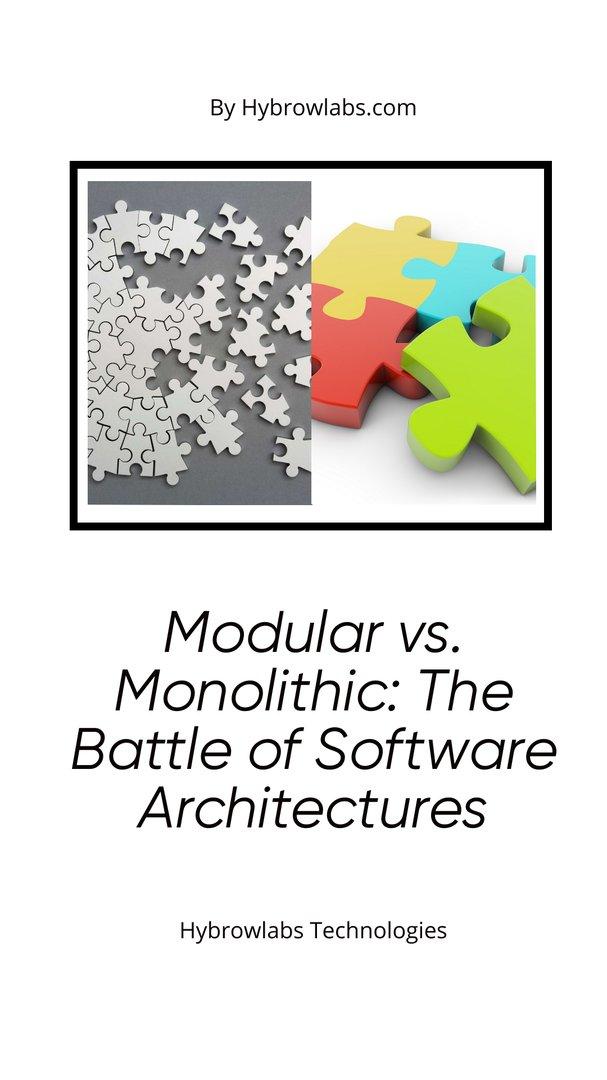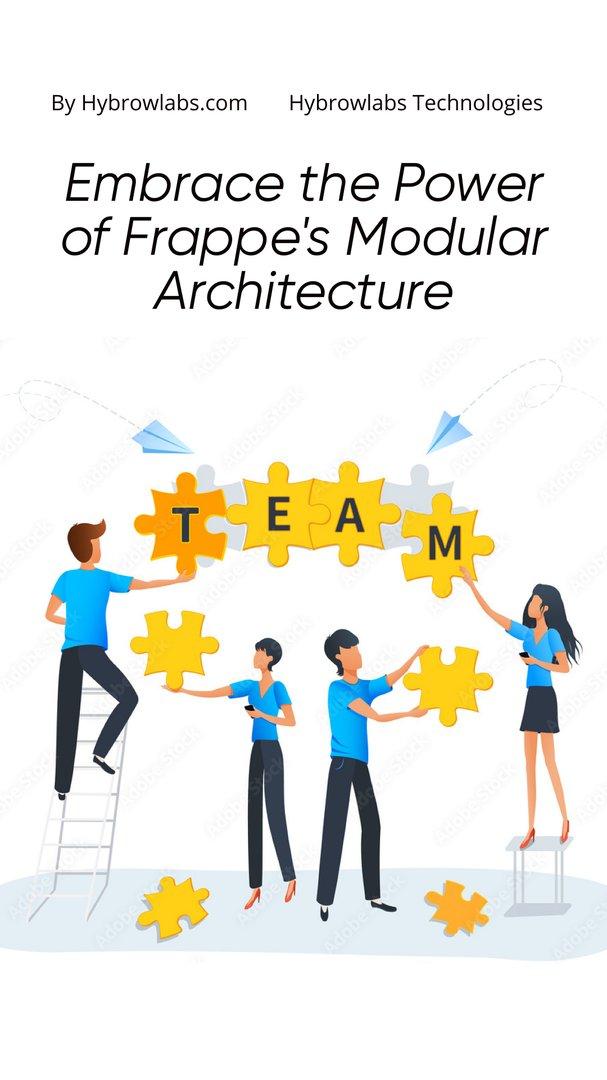 In the rapidly evolving world of software development, choosing between a modular architecture & a monolithic application has become a critical decision for businesses. Traditional monolithic applications are built as a single, self-contained unit, whereas modular architecture divides an application into separate, independent modules, each with its own functionality & interfaces. One modular architecture gaining popularity is Frappe, an open-source framework developed in Python that provides a scalable & flexible solution for creating web applications. With its modular architecture, Frappe offers numerous advantages over monolithic applications, & understanding these differences can help developers make informed decisions about the best approach to building their applications. In this article, we will explore Frappe's modular architecture & how it compares to monolithic applications.
In the rapidly evolving world of software development, choosing between a modular architecture & a monolithic application has become a critical decision for businesses. Traditional monolithic applications are built as a single, self-contained unit, whereas modular architecture divides an application into separate, independent modules, each with its own functionality & interfaces. One modular architecture gaining popularity is Frappe, an open-source framework developed in Python that provides a scalable & flexible solution for creating web applications. With its modular architecture, Frappe offers numerous advantages over monolithic applications, & understanding these differences can help developers make informed decisions about the best approach to building their applications. In this article, we will explore Frappe's modular architecture & how it compares to monolithic applications.
Definition of Frappe
Frappe is an open-source web application framework built on Python & JavaScript. It is designed to provide developers with a simple & powerful toolset to build complex applications quickly & efficiently. Frappe is widely used for building web-based business applications, including customer relationship management (CRM), enterprise resource planning (ERP), & human resource management (HRM) systems.
A brief explanation of modular architecture & monolithic applications
The modular architecture is an approach to designing software applications that breaks down the system into independent & interchangeable modules. Each module performs a specific function & can be developed & tested separately from other modules. The modules are then integrated to form the final system. This approach allows for greater flexibility, scalability, & maintainability of the system.
Monolithic applications, on the other hand, are designed as a single, self-contained unit. All the components of the application are tightly coupled, & any changes to one component can affect the entire system. This approach can make it difficult to scale the application & add new features or functionalities.
Frappe's modular architecture
As mentioned earlier, modular architecture is an approach to software design that breaks down the system into independent & interchangeable modules. Each module has a clear purpose & can be developed & tested separately from other modules. This allows for greater flexibility, scalability, & maintainability of the system.
Frappe is built using a modular architecture, which makes it highly flexible & easy to customize. The framework is composed of a set of independent modules that can be used to build a wide range of web-based applications. These modules include
a. Desk:
The Desk module provides a user interface for managing data in the application. It allows users to create, edit, & view records, as well as manage workflows & permissions.
b. Core:
The Core module provides the foundation for the application, including the database schema, data models, & API endpoints.
c. App:
The App module is used to create custom applications within the Frappe framework. Developers can use this module to create new modules or extend existing ones.
d. Integrations:
The Integrations module provides a set of pre-built integrations with popular third-party services, such as Google Drive, Dropbox, & PayPal.
e. Website:
The Website module provides a set of tools for building custom websites within the Frappe framework. This includes support for templating engines, content management, & SEO.
By using a modular architecture, Frappe allows developers to build complex applications quickly & efficiently. They can choose which modules to use & customize them to meet their specific needs. This approach also makes it easier to maintain & scale the application over time, as new features can be added without affecting the entire system.
Benefits of Frappe's Modular Architecture
1. Scalability
One of the major benefits of Frappe's modular architecture is its scalability. By breaking down the system into smaller, independent modules, it becomes easier to scale each module independently. This means that organizations can easily add new features & functionalities to their system without worrying about the entire system's performance. Additionally, it makes it easier to distribute the workload across multiple servers, thereby increasing the system's overall capacity.
2. Flexibility
Frappe's modular architecture is also highly flexible. Each module can be customized to meet specific business requirements, & new modules can be easily added to the system. This allows organizations to create a software system that is tailored to their unique needs, without sacrificing performance or stability.
3. Reusability
Another significant benefit of Frappe's modular architecture is reusability. Once a module has been developed, it can be reused in multiple applications, reducing development time & costs. This also ensures consistency across multiple applications & reduces the risk of errors & bugs.
4. Maintainability
Frappe's modular architecture makes it easier to maintain software systems. Each module can be tested & updated independently, making it easier to identify & fix bugs or issues. This reduces the risk of introducing new errors into the system while updating or fixing a module. Additionally, it is easier to replace or update a module without affecting the rest of the system.
5. Independent Deployment
Frappe's modular architecture allows for the independent deployment of modules. This means that each module can be deployed separately, without requiring a full system deployment. This reduces the risk of system downtime & makes it easier to deploy updates or new features without disrupting the entire system.
6. Improved Security
Frappe's modular architecture also improves system security. Each module can be isolated & secured independently, reducing the risk of a security breach affecting the entire system. Additionally, it is easier to monitor & audit each module's security, reducing the risk of security vulnerabilities going undetected.
Monolithic Applications
A monolithic application is a single, self-contained software application that contains all the necessary components. In a monolithic application, the front-end, back-end, & database are tightly coupled & interconnected. Any changes or updates to one component can affect the entire system.
Monolithic applications are often used for smaller projects or applications where scalability & flexibility are not essential. However, as applications grow, monolithic architecture can become difficult to maintain & scale. The tight coupling of components can make it challenging to add new features or functionalities without disrupting the entire system.
In a monolithic application, all components are deployed together, making it difficult to deploy updates or new features independently. Additionally, any issues or bugs in one component can affect the entire system, making it harder to identify & fix errors.
Furthermore, monolithic applications can be less secure as all components are interconnected, & a security breach in one component can affect the entire system. Additionally, as the system grows, it becomes harder to maintain & test, increasing the risk of introducing new errors or bugs while updating or fixing a component.
Challenges of Monolithic Applications
1. Scalability:
Monolithic applications are challenging to scale because they are tightly coupled. Scaling requires scaling the entire application, which can lead to performance issues & downtime.
2. Flexibility:
Monolithic applications are difficult to change because of their size & complexity. Adding new features or modifying existing ones requires changes to the entire application, which can be time-consuming & error-prone.
3. Reusability:
Monolithic applications are difficult to reuse because they are tightly coupled. It is challenging to extract specific functionality & use it in another application.
4. Maintainability:
Monolithic applications are challenging to maintain because they are complex & tightly coupled. A change to one part of the application can have unintended consequences elsewhere.
5. Coupling:
Monolithic applications are tightly coupled, which means that changes in one part of the application can have unintended consequences elsewhere.
6. Deployment complexity:
Deploying a monolithic application requires deploying the entire application, which can be time-consuming & error-prone.
 Comparing Frappe's Modular Architecture with Monolithic Applications
Comparing Frappe's Modular Architecture with Monolithic Applications
Key Differences between Modular Architecture & Monolithic Applications:
Frappe's modular architecture consists of small, independent modules that can be developed & deployed separately. Each module has its own API, & communication between modules occurs through APIs. In contrast, monolithic applications are large, complex applications that are tightly coupled.
Examples of Organizations Using Frappe's Modular Architecture:
Frappe's modular architecture is used by organizations such as ERPNext, a popular open-source ERP system, & DigiKala, the largest online retailer in Iran.
Conclusion
Frappe's modular architecture offers several advantages over traditional monolithic applications. Its highly scalable, flexible, reusable, maintainable, & loosely coupled architecture makes it an excellent choice for complex software applications. The use of Frappe's modular architecture has already been demonstrated by several organizations, indicating its success in the real world.
FAQ
1. What is Frappe's modular architecture, & how does it differ from a monolithic application architecture?
Frappe is an open-source web framework built on top of the Python programming language. Its modular architecture is a design pattern that allows developers to break down an application into smaller, independent modules or components that can be easily developed, tested, & deployed. Each module can be developed & maintained separately, allowing developers to add or remove functionality without affecting other parts of the application.
In contrast, a monolithic application architecture is a design pattern where all the components of the application are tightly coupled & interdependent. In a monolithic architecture, changes to one component can cause a ripple effect throughout the entire application, leading to increased development & maintenance costs.
2. What are the benefits of using Frappe's modular architecture?
Frappe's modular architecture offers several benefits to developers, including increased flexibility, scalability, & maintainability. By breaking down an application into smaller, independent modules, developers can work on each module separately, allowing for faster development & testing. Additionally, because each module can be developed & maintained independently, it is easier to add or remove functionality without affecting the entire application.
Frappe's modular architecture also makes it easier to scale an application. Because each module can be scaled independently, it is easier to handle increases in traffic or demand. This modular architecture also makes the application more maintainable. If a bug or issue is discovered in one module, it can be fixed without affecting the rest of the application.
3. What are some drawbacks of using Frappe's modular architecture?
While Frappe's modular architecture offers several benefits, it also has some drawbacks. One of the main drawbacks is that it can be more complex to implement than a monolithic architecture. Developers must carefully design each module & ensure that they are all communicating effectively. Additionally, because each module is developed & maintained independently, it can be challenging to ensure consistency across the entire application.
Another drawback of Frappe's modular architecture is that it can be more difficult to debug & troubleshoot issues. Because each module is independent, it can be challenging to trace issues that span multiple modules.
4. What are the benefits of using a monolithic application architecture?
A monolithic application architecture offers some benefits over Frappe's modular architecture. One of the main benefits is that it is often easier to implement & maintain. Because all the components are tightly coupled, it is easier to ensure consistency across the entire application. Additionally, because all the components are in one place, it is often easier to debug & troubleshoot issues.
A monolithic application architecture can also be easier to deploy & scale in certain situations. Because all the components are in one place, it can be easier to manage deployments & scaling.
5. What are some drawbacks of using a monolithic application architecture?
While a monolithic application architecture offers some benefits, it also has several drawbacks. One of the main drawbacks is that it can be challenging to develop & maintain. As the application grows in size, it can become increasingly difficult to manage all the interdependent components. Additionally, because all the components are tightly coupled, changes to one component can have a ripple effect throughout the entire application, leading to increased development & maintenance costs.
A monolithic application architecture can also be more difficult to scale. Because all the components are tightly coupled, it can be challenging to scale individual components independently. This can lead to increased costs & complexity when trying to scale the entire application.






a3dc85.jpg)

.jpg)
fd8f11.png)


.jpg)
.jpg)